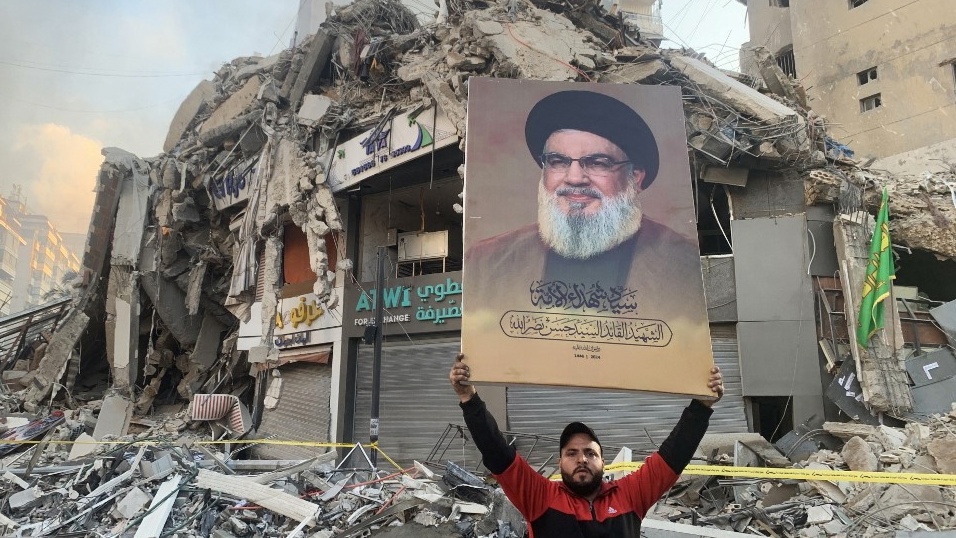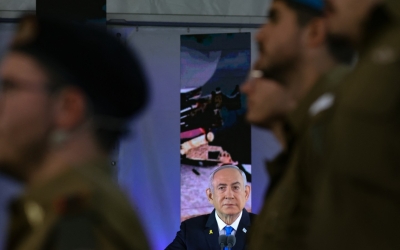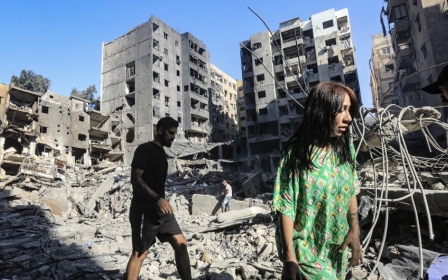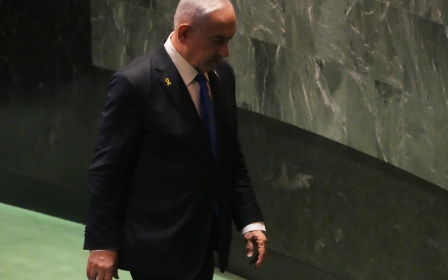Hezbollah rebuilds resistance as national unity prevails, for now

Hezbollah is currently fighting on two fronts: resisting the Israeli army, while also managing internal political and social pressures within Lebanon.
On Monday, Hezbollah recorded a peak in the number of rockets and missiles it launched at the north, sending nearly 250 projectiles and several squadrons of attack drones towards the Safed, Acre and Haifa regions, where much of north's population is concentrated.
This intensified bombardment comes more than a month after Israel began its ground offensive on 1 October. It also coincided with Hezbollah’s 11 November Martyrs’ Day, an annual celebration that commemorates those who died in battle.
To mark the occasion, Hezbollah spokesperson Mohammad Afif held a news conference in the heart of Beirut’s southern suburbs, largely destroyed by hundreds of Israeli air raids.
Journalists carefully made their way through the ruins, amid the smell of gunpowder and burning, to the Lord of Martyrs complex, where former Hezbollah leader Hassan Nasrallah, who was assassinated by Israel in September, often addressed crowds.
New MEE newsletter: Jerusalem Dispatch
Sign up to get the latest insights and analysis on Israel-Palestine, alongside Turkey Unpacked and other MEE newsletters
The intensification of strikes on Israel and the news conference in Hezbollah’s Dahiyeh stronghold were symbolic acts of defiance, as Israeli Prime Minister Benjamin Netanyahu maintains that the ultimate goal of this war is to “change the strategic reality” of the Middle East region.
This significant ambition would, if realised, require the destruction of Hezbollah - the cornerstone of the “resistance axis” and an inspiration to anti-Israel movements from Iraq, to Yemen, to Syria and beyond.
Heavy blows
Through these symbolic actions, Hezbollah aims to show both its enemies and its own supporters, deeply shaken by recent setbacks, that it remains resilient and committed to the fight.
Hezbollah has suffered a series of heavy blows since the coordinated explosions of its communications devices in mid-September, followed by Israel’s assassinations of its top officials, including Nasrallah. Israel has also conducted thousands of air raids and sent thousands of troops into Lebanon. These troops, however, failed to occupy any village in the south.
“We have a strong will to fight, and we have reorganised and prepared for a long war,” Afif said, noting that the war’s outcome would determine the “fate of the resistance, and the future of Lebanon and the Middle East”.
On Wednesday, nine Israeli soldiers were killed in south Lebanon when Hezbollah fighters targeted a house they occupied.
Follow Middle East Eye's live coverage of the Israel-Palestine war
After a period of uncertainty following Nasrallah’s assassination, there have been signs of Hezbollah’s recovery. The election of Naim Qassem as party leader has allowed the group to start rebuilding its leadership structure, while new commanders have been appointed to replace those killed in recent months.
“All vacant positions have been filled,” Qassem said in his first speech as Hezbollah’s new secretary general late last month.
Videos posted by residents in northern Israel showed salvos of rockets being launched from border villages that the Israeli army claimed to have 'cleared'
Since Qassem took the helm of Hezbollah, observers have noted a complementarity between his political positions and military actions on the ground, viewed as evidence of a restored command-and-control structure. Security sources told Middle East Eye that Hezbollah had sent reinforcements - comprising hundreds of fighters - to southern Lebanon after implementing a new reservist mobilisation system.
Hezbollah has also managed to maintain a steady pace of daily rocket and drone attacks on Israel. In recent days, it has deployed precision Fateh 110 missiles, with a range of 300 kilometres and a 500-kilogramme explosive payload.
The Israeli army, meanwhile, has advanced into several Lebanese border towns, and claims to have discovered and destroyed Hezbollah tunnels and weapons caches. But it did not fully secure these towns, withdrawing from Khiam earlier this month, thus enabling Hezbollah to resume its missile attacks.
On Monday, videos posted by residents in northern Israel showed salvos of rockets being launched from border villages that the Israeli army claimed to have “cleared”.
Internal pressures
Hezbollah’s task is further complicated by growing internal political and social pressures. It must, first and foremost, manage the displacement of more than one million people, representing its popular base, forced into exile by the war.
These displaced people are now living in harsh conditions. While Hezbollah anticipated this scenario by stockpiling large quantities of food, mattresses, blankets, medicines and other essentials, Israeli air strikes destroyed many of these supply bases in southern Lebanon, the southern suburbs of Beirut and the Bekaa Valley.
In addition, the coordinated pager and walkie-talkie explosions in late September injured significant numbers of Hezbollah’s staff members in social and medical institutions, according to party sources, who would have been responsible for managing a potential exodus. This helps to explain the confusion that initially followed the mass displacement of Lebanese civilians in the early days of Israel’s war, with thousands of people spending nights in tents in the streets.
The situation has somewhat improved with the reorganisation of Hezbollah’s resources,
as confirmed on Wednesday by Hezbollah MP Hassan Fadlallah during a press conference, as well as the emergency plans implemented by the Lebanese state, and assistance from associations and NGOs. But the needs are still greater than these efforts.
Hezbollah also faces rising criticism from its political opponents, particularly in the Christian sphere, who blame it for the war. “Western ambassadors, primarily from the United States and Germany, encourage Hezbollah’s enemies in Lebanon to increase their pressure and leverage its weakening to attempt political isolation,” an independent MP told MEE on condition of anonymity.
Delicate balance
Last week, Samir Geagea, a former warlord and head of the Christian Lebanese Forces party, said in a televised interview that he would agree to a parliamentary session to elect a new president without the participation of Shia MPs (the role has been vacant since October 2022). But his position is far from unanimous, even among Christians.
“The election of a president without the participation of one of the main Lebanese communities is unrealistic,” former foreign minister, Fares Boueiz, told MEE. “In Lebanese history, a president has never been elected as a challenge to the country’s other confessional groups. The president has always been at least somewhat accepted by all communities. History has taught us that a president elected without community consensus cannot govern, leading to institutional paralysis.”
Ahmad Qabalan, a senior religious leader close to Parliament Speaker Nabih Berry recently confirmed that parliament would not convene to elect a president without Shia MPs: “Lebanon … is governed by consensus, and the alternative to consensus is ruin,” he warned.
According to Boueiz, a moderate Maronite political figure, Lebanon "is built on delicate confessional balances, and each time one of its religious communities takes on a larger role than its natural weight, it creates an imbalance,” he said.
Despite these divisions, Boueiz downplayed the severity of Lebanon’s intercommunal tensions. “We are witnessing a surge of national solidarity, expressed through positive attitudes toward displaced populations,” he said. “Frictions do exist, but they remain marginal and don’t threaten national unity.”
But while no serious cracks have yet appeared in Lebanon’s internal front and Hezbollah is proving to be a formidable foe to Israel, the independent MP warned, "tensions could escalate if the war drags on".
The views expressed in this article belong to the author and do not necessarily reflect the editorial policy of Middle East Eye.
Middle East Eye delivers independent and unrivalled coverage and analysis of the Middle East, North Africa and beyond. To learn more about republishing this content and the associated fees, please fill out this form. More about MEE can be found here.






